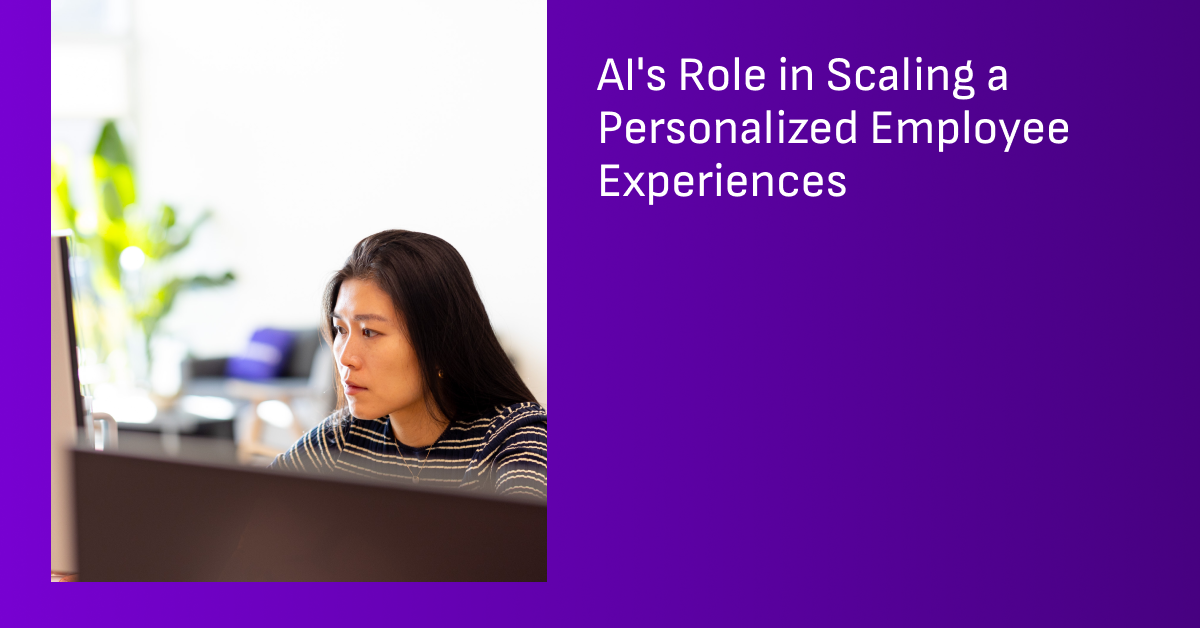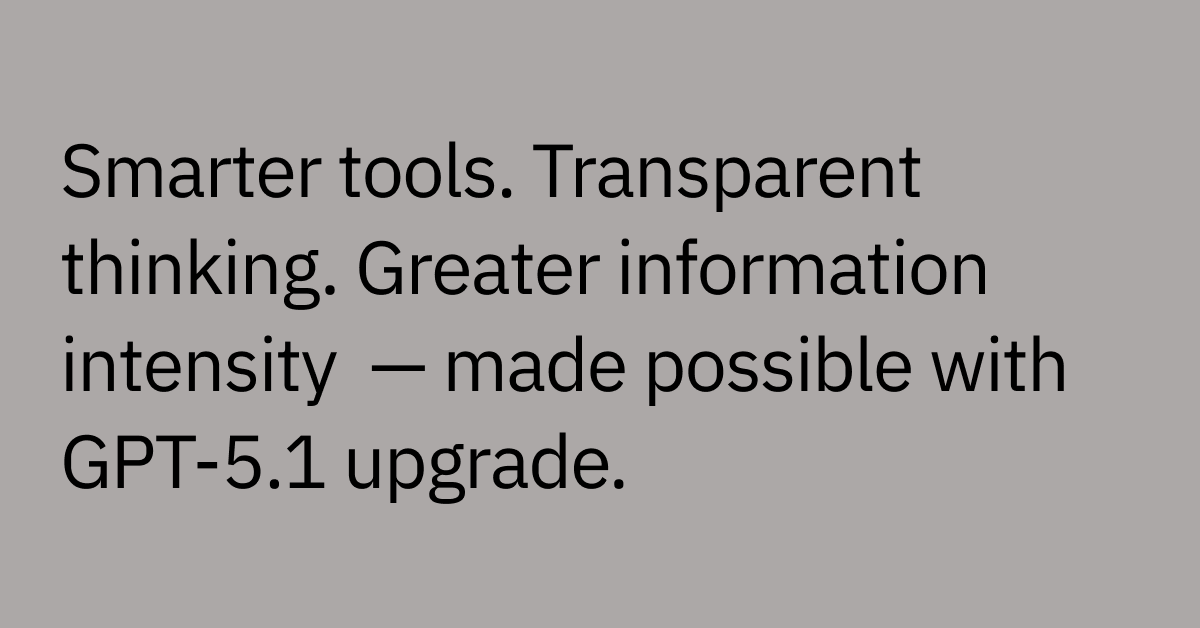Table of contents
Highlights
- Personalized employee experience goes beyond perks, it’s about delivering timely, relevant experiences based on each employee’s role, location, and needs.
- Core elements of personalization include context-aware support, in-the-flow delivery (via Slack, Teams, etc.), and automation that adapts to individual roles.
- Personalization directly impacts engagement, performance, and retention by making employees feel seen, supported, and empowered to do their best work.
- Traditional systems fall short because they rely on static workflows, siloed departments, and generic communication that create friction and delay.
The last time you asked IT for help setting up a new app, did you get a generic email with links to three different knowledge base articles? Or did someone understand what you needed for your role and location, then get it done in minutes?
Many employees have the first experience.
Only 52% of employees report feeling good about their company's onboarding process, and the gap between what people expect and what they receive seems to keep growing.
Here's what's happening: employees now expect the same personalized, instant support they get as consumers. When Netflix knows what you want to watch and Amazon delivers your order the next day, waiting three days for IT to provision software access feels frustrating.
Companies (and you, perhaps) are caught between two impossible choices: do you deliver personalized support manually (which doesn't scale), or stick with one-size-fits-all systems (which frustrate everyone)?
As it turns out, there's now a third option.
Artificial intelligence (AI) makes it possible to deliver personalized employee experiences at enterprise scale. Instead of choosing between efficiency and personalization, you get both. Who says you can't have it all?
What is a personalized employee experience
Employee experience is the sum of every interaction an employee has with their organization—from the moment they accept an offer to their day-to-day work, support requests, career development opportunities, and even the exit interview process. It includes how employees feel about the tools, processes, communication, and culture they encounter throughout the employee lifecycle.
A personalized employee experience means tailoring support, resources, answers, answers, and actions to each employee's unique needs—role, —role, location, language, permissions, permissions, and current current context.
AI helps to provide a personalized employee experience by offering instant on-demand support and information tailored to the individual's role, location, and company context.
AI is able to analyze employee data to proactively deliver customized resources, such as recommending specific training, checking on well-being, or streamlining complex HR and IT workflows.
This approach goes beyond generic solutions. It delivers relevant, timely, and meaningful experiences in the flow of work (Slack/Teams or web) in the flow of work (Slack/Teams or web) too help employees stay productive, engaged, and supported throughout their employee lifecycle.
Personalization can include everything from custom onboarding workflows to role-based IT support to localized information, all of which can be powered by automation and AI to scale across large, diverse workforces. It means that people only see what’s relevant to their role, location, and permissions to get exactly what they need, when they need it.s.
It means that people only see what’s relevant to their role, location, and permissions to get exactly what they need, when they need it.s.
It's like getting a generic FAQ response, versus having someone say, "I see you're in marketing and based in London, so here's what you need." See the difference?
Go beyond perks and segmentation
True personalization isn't about offering different health benefits or sending targeted newsletters. Understanding each employee's context when they need help is the goal.
Imagine two new hires starting the same day: a software engineer in Denver and a sales manager in Berlin. Traditional systems would send them both the same "Welcome to the company!" email with a link to the employee handbook.
Personalized systems understand context. So, in this example:
- The engineer would get immediate access to development tools, code repositories, and information about local tech meetups.
- The sales manager would receive CRM credentials, regional sales targets, and GDPR compliance training specific to their location.
This level of support requires systems that understand role, location, permissions, and individual workflows, going beyond broader departments or job titles.
Why personalization matters more than ever
Employee expectations have shifted dramatically. Remote and hybrid work means people rely more heavily on technology to get help, stay connected, and remain productive.
They expect consumer-like experiences at work. When Spotify creates personalized playlists and your maps app knows your morning commute patterns, generic workplace systems feel outdated and impersonal.
The stakes are higher, too. Companies with engaged employees report 14% higher productivity. When it comes to retention, poor experiences can drive top talent to leave, even when they like their actual job.
Global workforces add even more complexity. An employee in Tokyo shouldn't receive the same policy reminders as someone in São Paulo. Time zones, languages, local regulations, and cultural contexts all matter.
Personalized employee experience means you get answers ailored to role, location, permissions, language, and context—right in the flow of work. Unifying identity, knowledge, and workflows is the key to instantly finding what you need, exactly when you need it, deflecting support tickets, and boosts productivity while preserving a white‑glove feel at scale.
Learn strategies to boost engagement through employee communications.
Where improving employee experience gets stalled
Creating better employee experiences sounds straightforward until you try to do it. Most organizations encounter the same predictable roadblocks that hinder real progress, along with traditional approaches that prioritize internal convenience over employee needs.
You cYou can't improve what you can't measure
Many IT and HR leaders operate without reliable data (or shared definitions) of employee experience. Service desk analytics show ticket volumes but miss the employees who gave up before getting help. Annual surveys can capture sentiment, but don't reveal specific pain points in daily workflows.
Without trustworthy data, you might know something's wrong, but struggle to prioritize fixes or measure progress. IT tracks resolution times while Human Resources measures employee engagement scores, resulting in fragmented visibility across departments.
Different teams focus on separate data-driven metrics without understanding how their work affects the overall employee experience. This makes it hard to align on solutions or show the impact of improvement initiatives.
One-size-fits-all systems and workflows
Most enterprise systems prioritize administrative efficiency over personalized experiences:
- Everyone sees the same portal homepage.
- Knowledge bases organize content by department instead of individual need.
- Onboarding follows identical steps, regardless of role or location.
A contractor in Munich doesn't need the same benefits information as a full-time employee in Miami. A marketing manager doesn't need access to the same systems as a software developer.
When employees encounter generic experiences that don't match their situation, they may abandon self-service entirely, potentially leading to more support tickets and longer wait times for everyone.
Manual processes and siloed support
Disconnected support systems across HR, IT, and other departments can create repetitive workflows and inconsistent experiences. One employee might submit separate requests for system access, equipment, and workspace setup, then wait while each individual department does their thing behind the scenes.
These silos create predictable problems. Employees don't know which team handles their needs, while support teams duplicate work or pass requests around. Important details can also get lost between handoffs.
And those hidden costs add up. Support teams spend too much time on coordination instead of strategic projects, and employees get frustrated and disengage from company systems.
How AI creates a personalized experience at enterprise scale
AI systems now allow for personalized employee experiences, which previously required extensive manual effort. These systems understand context, make intelligent decisions, and coordinate actions across various systems. Intelligent workflows adapt to individual employees and situations, moving beyond simple task automation.
The difference lies in how these systems handle complexity and scale:
- Traditional automation handles simple, rule-based tasks like sending reminders or routing tickets. These systems follow "if-then" logic without understanding context or making complex decisions. They work fine for basic workflows, but can break down with exceptions or edge cases.
- AI systems powered by machine learning can analyze data, recognize patterns, and make predictions about employee behavior and needs. They can also provide insights into sentiment and performance patterns, but they usually require human oversight to take action.
- Agentic AI comprises intelligent agents capable of autonomous decision-making, learning, and executing complex tasks across multiple enterprise systems, and dynamically adapting to new information and situations.
Use AI to understand intent and automate action
AI systems can interpret employee questions in real time and respond with personalized support based on their specific role, location, and permissions.
When an employee asks, "How do I access the VPN?" AI doesn't just provide generic instructions. It uses reasoning and your business context and is able to uses reasoning and your business context and is able to check their permissions, confirms eligibility, and delivers step-by-step guidance for their device and location. If they need additional access, it can be provisioned automatically.
This can can eliminate the back-and-forth that typically happens with support tickets, while getting employees exactly what they need.
Break down silos between HR, IT, and other teams
Integrated AI workflows can deliver consistent experiences regardless of where employees make requests. Whether someone asks a question in Slack, through a web portal, or via email, they get the same level of personalized support.
AI can coordinate actions between teams while maintaining clear accountability for each interaction. This unified approach requires shared ownership across departments, but can ultimately deliver much better employee experiences.
Continuously adapt based on data and feedback
Personalization can even improve over time through continuous learning from employee interactions and feedback. AI systems can track which responses help, identify common pain points, and identify optimization opportunities automatically.
This means employee experiences get better without manual updates to scripts or workflows. The system learns from each interaction and applies that knowledge to future requests.
Read our blog on employee experience metrics and start driving meaningful improvements for your company.
Personalized employee experience across the entire lifecycle
AI can help personalize experiences throughout the employee journey, from initial onboarding through daily support and career development opportunities. By connecting systems and understanding context, AI can provide cohesive experiences that adapt to each person's evolving needs.
Support with context
AI can understand employee needs through natural conversation, find solutions instantly, and adapt responses based on individual context, like role, location, and permissions.
Instead of surfacing the same onboarding materials to software developers and sales managers, AI can personalize that content automatically. When an employee asks for onboarding support, it identifies resources for engineers versus sales assets and routes approvals based on organizational structure.
AI systems can also provide equitable support across regions by communicating in multiple languages and understanding local context, ensuring global workforces get consistent but culturally relevant experiences.
Personalized touchpoints across the lifecycle
AI systems can predict and help to prevent common issues before they become problems. They can send proactive reminders about compliance deadlines, benefits enrollment, or training requirements based on individual employee data.
This helps build personalized employee journeys that balance global consistency with local relevance. Instead of reactive support, employees receive timely guidance that keeps them on track.
Learn more about how HR leaders are using AI to drive performance from hire to retire.
In-the-flow delivery of help
Support delivered within tools employees already use (like Slack, Microsoft Teams, and web portals) feels more natural and accessible than centralized help desk systems.
When employees get help where they're already working, adoption can increase while resolution times decrease. AI streamlines policy delivery and case triage, reducing routine inquiries and freeing up HR teams for strategic work.
Customized communications
AI can send targeted communications based on role, region, language, language, and individual context. This includes reminders to enroll in benefits, complete required training, and participate in relevant company events.
Employees receive contextual contextual information when they need it in the flow of daily work, rather than filtering through mass communications that don't apply to them. This approach can help reduce email overload while improving action rates.
Delivering a personalized experience with smarter support from Moveworks from Moveworks
Creating personalized employee experiences comes down to a pretty simple principle: when people need help, they get it fast. When they need access, it works. When they have questions, they find answers.
While many companies try to improve employee experience with better perks or team events, the real problems happen during daily work, with many issues that could be automated.
Moveworks AI Assistant overcomes these everyday obstacles by:
- Automating routine requests almost instantly: Address password resets, app access, PTO checks, payslip lookups, and policy questions in minutes instead of hours or days—directly in Slack or Teams.
- Understanding context to personalize help: Answers with context of role, location, language, and permissions, so people are able to get only what’s relevant and can take action immediately.
- Orchestrating case management across systems: Files, updates, and tracks case status automatically, routing to the correct team—even when different departments use different platforms.
- Communicating proactively and at scale: Sends targeted, multilingual reminders and updates that drive action, with engagement tracking.
When Moveworks helps remove everyday friction, organizations often see meaningful improvements across the employee experience. Satisfaction tends to rise, engagement strengthens, and indicators like turnover and absenteeism rates may decline over time. By making support faster—and in many cases, nearly invisible—employees can stay focused on meaningful work instead of wrestling with internal systems.
Explore more AI solutions designed specifically for HR teams.
Frequently Asked Questions
A personalized employee experience tailors support, communication, tools, and workflows to each employee’s unique role, location, and needs rather than offering a one-size-fits-all approach.
Personalization increases engagement, reduces friction, and helps employees feel supported and valued, which leads to higher productivity and better retention.
Traditional strategies often focus on company-wide programs, while personalization adapts to the individual, delivering relevant resources and support based on context and intent.
Examples include tailored onboarding paths, role-specific access to tools, AI-powered self-service support, and customized communication or learning content.
Organizations can use AI and automation platforms like Moveworks to dynamically understand employee needs and deliver timely, role-based support across IT, HR, and other functions.



